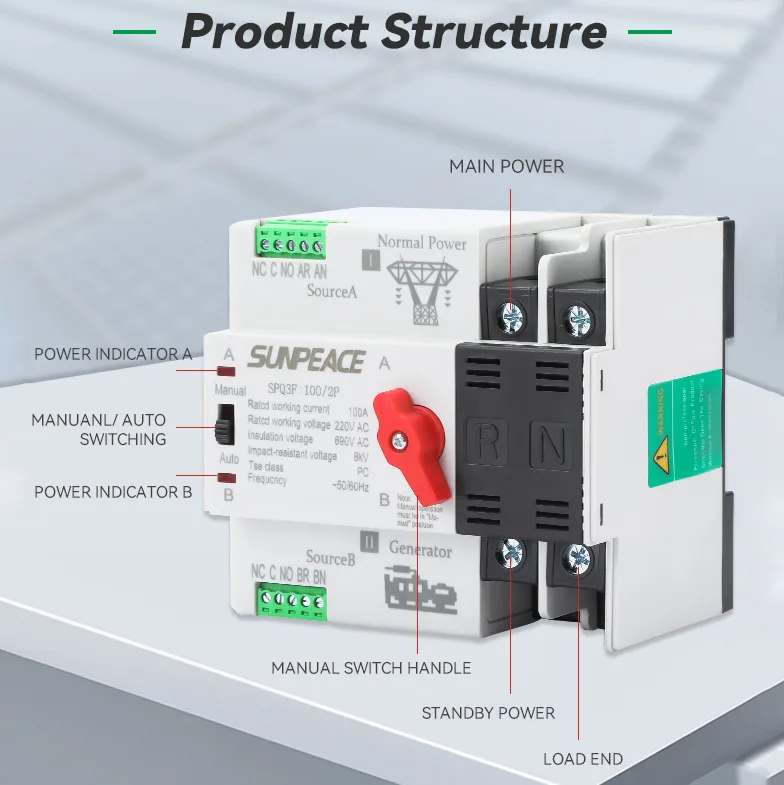Why Do You Need a Special Circuit Breaker for DC Power
Company News, News 2025-11-19
For over two decades at Sunpeace, I have fielded one question more than any other. Customers often ask me, “Can’t I just use a standard AC breaker for my DC system?” It is a logical question, but the answer is a definitive no. The physics of interrupting AC and DC power are fundamentally different, and using the wrong component is not just inefficient—it is a genuine safety hazard. Having spent twenty years designing and testing protection systems, I have seen firsthand the critical importance of a properly engineered DC Circuit Breaker. The difference is not just in the specification sheet; it is in the security and longevity it provides to your entire electrical infrastructure.

What Makes DC Power So Much Harder to Interrupt
Think about the flow of electricity. Alternating Current (AC) naturally crosses zero 100 or 120 times per second. This zero point is a built-in opportunity for an arc to extinguish itself easily. Direct Current (DC) has no such mercy. It is a constant, relentless stream of power. When you try to interrupt a DC circuit under load, the arc that forms does not have a natural point to die. It can sustain itself, creating intense heat that can weld contacts together, damage equipment, and even cause fires. A standard AC breaker is simply not designed to stretch and cool this persistent DC arc effectively. This is why a dedicated DC Circuit Breaker is not an accessory; it is a necessity for any safe DC application, from solar farms to industrial machinery.
How Does a Dedicated DC Circuit Breaker Solve This Critical Problem
A true DC Circuit Breaker, like the ones we engineer at Sunpeace, is built from the ground up to tackle the unique challenge of DC interruption. We do not just re-label an AC component. We design mechanisms that forcefully stretch the DC arc into arc chutes filled with specialized splitter plates. This process cools the plasma, increases its voltage, and forces it to extinguish rapidly and safely. It is a violent, contained event inside the breaker that protects everything outside of it. Our two decades of research have gone into perfecting this chamber, ensuring that when our breaker trips, the fault is cleared decisively without compromising the unit’s integrity. This core technology is what sets a specialist apart and is the bedrock of our product development at Sunpeace.
What Key Parameters Should You Scrutinize in a DC Circuit Breaker
When you are specifying a DC Circuit Breaker, looking at the datasheet with a trained eye is crucial. Here are the non-negotiable parameters I always advise our clients to verify
- Rated Operational Voltage (Ue): This must match or exceed your system’s maximum DC voltage. Underspecifying here is a common and dangerous mistake.
- Rated Current (In): The continuous current the breaker can carry without tripping.
- Pole Configuration: 1P, 2P, or 3P, depending on your system’s grounding and configuration.
- Breaking Capacity (Icu): This is critical. It is the maximum fault current the breaker can safely interrupt. Your system’s potential short-circuit current must be less than this value.
To present this with the clarity our engineers appreciate, here is a comparison of two of our popular models
| Rating | Specification | |||||
|---|---|---|---|---|---|---|
| Frame size | 63A | |||||
| No. of poles | 1P, 2P, 3P, 4P | |||||
| Rated current, In | 1, 2, 3, 4, 6, 10, 16, 20, 25, 32, 40, 50, 63A | |||||
| Rated operational voltage, Ue DC | Reference standard | Poles | 1P | 2P | 3P | 4P |
| IEC 60947-2,Icu | Rated voltage | 250V | 500V | 750V | 1000V | |
| Breaking current | 10kA | 10kA | 10kA | 10kA | ||
| Rated insulation voltage, Ui | 1000V | |||||
| Rated impulse withstand voltage, Uimp | 6kV | |||||
| Trip characteristic | B (5In), C (8In) | |||||
| Protection | Overload and short circuit | |||||
| Endurance life (times) | Electrical | 1,500 | ||||
| Mechanical | 20,000 | |||||
| Degree of protection | IP20 | |||||
| Tightening torque | 18-4 AWG (0.75 … 25mm²) / 20 Kgf.cm | |||||
| Installation | Mounting on 35mm DIN rail | |||||
| Type of Terminal | Lug type | |||||
| Type of trip | Thermal-Magnetic | |||||
| Ambient temperature | 40°C (Standard), -25~ +25°C (Use) | |||||
| Approval | CE, SEMCO, CB | |||||
This table is not just a list of numbers. It represents years of solving real-world problems. The higher breaking capacity in our DZ47 Series, for instance, was a direct response to the growing energy density in modern battery storage systems, a challenge we proactively addressed.
Where Can the Wrong DC Protection Lead You Astray
I have been called to failure analysis sites where the root cause was an underspecified or incorrect protection device. The results are never pretty. We see melted busbars, charred control panels, and entire inverters taken offline. The financial cost of downtime and repair often dwarfs the initial “savings” from using a non-specialist component. More importantly, it creates a significant safety risk. A proper DC Circuit Breaker is your first and most reliable line of defense. It is the component that stands between a minor fault and a catastrophic failure. Choosing a partner with a proven track record, like Sunpeace, is not just a procurement decision; it is a risk management strategy.
Are You Ready to Secure Your DC System with Confidence
The question is not whether you can afford a high-quality DC Circuit Breaker, but whether you can afford the consequences of not having one. For twenty years, our mission at Sunpeace has been to provide that absolute peace of mind. We have embedded our extensive field experience into every product, ensuring they perform not just on the test bench, but in the demanding environments where you need them most. Do not let your protection be an afterthought.
Your project’s safety and efficiency deserve the specialized protection that only a true DC specialist can provide. Contact us today to discuss your specific requirements. Our team of experts is ready to help you select the perfect Sunpeace solution. Visit our website or reach out directly to get started and secure your system with confidence.

